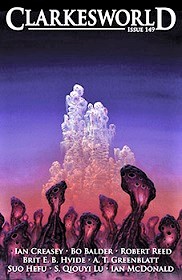 Clarkesworld #149, February 2019
Clarkesworld #149, February 2019
“East of the Sun, West of the Stars” by Brit E. B. Hvide
Reviewed by Victoria Silverwolf
Five original short stories and one new novelette fill the pages of the latest issue of Neil Clarke’s monthly magazine. A recurring theme is a future Earth facing ecological disaster. Many of the tales mix science fiction with themes borrowed from fantasy.
The narrator of “East of the Sun, West of the Stars” by Brit E. B. Hvide is a woman who is a member of a sect resembling the Amish. Her people flee a dying Earth on a generation starship. Although they had to learn advanced technology to survive, they also preserved their traditional ways. The woman has erotic dreams of a bear-man from a fairy tale. A widow with a young son, she remarries aboard the ship and bears a daughter. The child is strange, not at all like her brother. The woman imagines her to be the offspring of her ursine lover. Her discovery of the truth leads to an emotional crisis.
Although the premise is intriguing, it is very difficult to believe that people with a tradition of rejecting modern technology would be able to launch and maintain a starship. The protagonist is an adult, but often seems like a naïve child. Her reaction when she learns the origin of her daughter is immature.
“Painwise” by prolific, award-winning author Robert Reed takes place in a near future ravaged by a neurological disease. The illness attacks nearly half of the human race. It causes unpredictable, severe pain throughout the body. Those who escape from the disorder suffer as well, as they must go to extreme measures to care for their loved ones.
Most of this story is an impressionistic account of how the disease leads to a bleak, desperate society. An unexpected turn in the plot offers a touch of transcendent joy. Rather than offer the reader a bland happy ending, however, the author provides a sad, ironic conclusion. The story manages the difficult task of avoiding sentimentality while not becoming overly depressing.
“The Final Ascent” by Ian Creasey is the issue’s longest story. Glands in the bodies of aliens allow them to have an afterlife once they have died. The narrator is a terminally ill man who is the first human to have one of these glands transplanted into his body. He dies and becomes a ghost, joining the specters of deceased aliens. The afterlife turns out to be mostly boring and depressing, but the narrator finds a way to become useful to the aliens.
This mixture of science fiction and fantasy has an interesting concept, but one that strains credibility. The story ends with a battle scene that seems out of place. The way in which the afterlife works is sometimes confusing.
In “Give the Family My Love” by A. T. Greenblatt, a woman travels to a vast alien library. Her goal is to recover vital human knowledge lost during an ecological catastrophe, but preserved by the aliens. After a dangerous struggle to reach the library, she discovers that it is nearly impossible to understand its strange technology, so advanced that it seems magical. Eventually she finds what she needs, and makes a decision that changes her life.
The best part of this story is the description of the bizarre, constantly changing library. The narrative style is informal and often humorous, not always in an appropriate way.
The title of “The Face of God” by Bo Balder is quite literal. A gigantic human figure, presumed to be God, falls to Earth. Pieces of its flesh have extraordinary healing properties. Adventurers undergo the difficult process of climbing the body to obtain the most valuable specimens. The narrator makes an obsessive journey to the eye of God, and learns something important about the enormous deity.
The description of the expedition to God’s face is detailed and vivid. Readers familiar with “The Giant Mole” by Franz Kafka or “The Drowned Giant” by J. G. Ballard will realize that the idea is not completely original.
“The Butcher of New Tasmania” by Suo Hefu (translated from Chinese by Andy Dudak) takes place in the far future, long after a galactic confederation collapsed. A starship from a new confederation journeys to a colony planet out of communication during the interregnum. What they discover horrifies the narrator. He takes measures against the menace, leading to accusations of genocide. The story takes the form of a statement justifying his action.
This is an old-fashioned, plot-driven story that might have appeared in the pages of an American science fiction magazine in the middle of the last century. The encounter with the inhabitants of the lost colony is melodramatic. The charge of genocide is very misleading, as the reader discovers when the narrator explains his activities.
Victoria Silverwolf got extra money from a vending machine today.